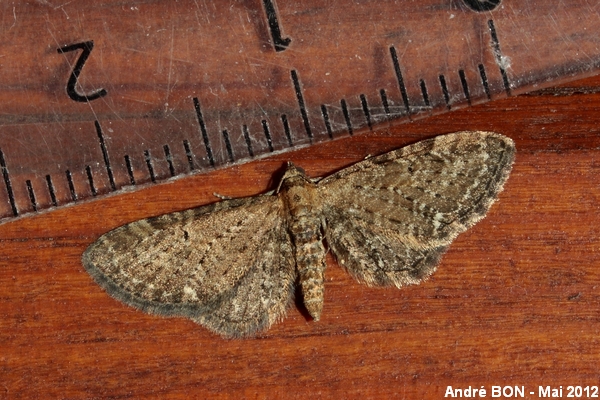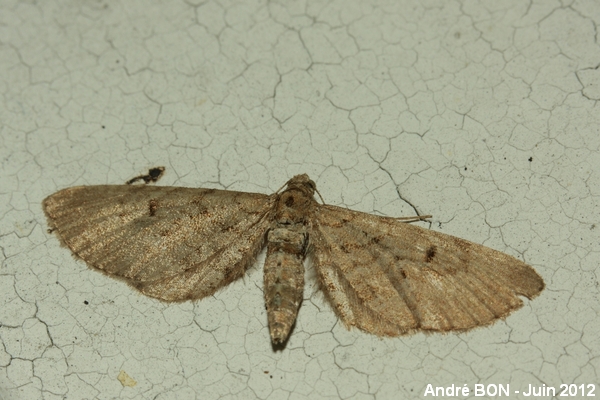

| Common Pug (Eupithecia vulgata (Haworth, 1809)) |


|
|
Scientific name: Eupithecia vulgata (Haworth, 1809) Common name: Common Pug French name: Eupithécie austère Order: Lepidoptera Suborder: Heterocera Family: Geometridae Subfamily: Larentiinae Wingspan: 15 to 23 mm. Biotope: Various habitats because of the large number of host plants. Geographic area: Palaearctic region, Near-East and North Africa, form Ireland to Korea. Flight time: April to June then August to September. Number of generations : 2 Caterpillar: The caterpillars occurs in several forms, from very light brown to green or blackish brown. It shows a row of dark diamond-shaped markings on the upper side (this particularity is also found on many other species of the same genus). Host plant: Various plants and shrubs including Knotgrass (Polygonum), Brambles (Rubus), Willows (Salix) and Hawthorns (Crataegus). |
The Eupithecia genus of the Geometridae family includes more than 1400 known species. They are found worldwide and at least 96 species are listed as present in metropolitan France (including Corsica). These are small moths with a typical resting position holding the costal edge of their fore wings at a right angle from the body. The fore wings are rather narrow with a rounded apex. Three quarter of the hind wings are then hidden below the fore wings. Telling species apart on picture is very difficult because of the large number of species and because of variations inside a single species. The Common Pug shows a greyish brown ground colour but you can find important variations including a melanic form. The wings are crossed by angulous lines. The postmedial band shows two almost right angles close to the costal edge. The veins are marked with black and white. There is a submarginal white line on the fore wing with one more distinct white mark close to the anal angle. The fringe of the fore wings is chequered with pale and dark. The Common Pug over winters as a chrysalis. Among similar species let's mention the White-spotted Pug (Eupithecia tripunctaria) whose white submarginal markings seem to appear as three distinct spots. As these markings are however rather variable, the best way to tell the White-spotted Pug apart form the Common Pug is by the presence of a white spot on the upper side of the thorax. The Brindled Pug (Eupithecia abbreviata) does not show a so well marked submarginal white line. The discal spot on the fore wings is clearly elongated and bordered with white towards the apex of the wing. |
| [To know more about the Common Pug] [Next picture] [Top] |

|
I have photographed this moth landed on the front door of my house. It has not been very shy as I have been able to position a ruler to measure the exact wingspan. As I do not have much experience about Pug moths, the identification of this species is to consider with some reserves. |
| [To know more about the Common Pug] [Previous picture] [Top] |

|
I have not been able to tell better than Eupithecia sp. with this picture. I have found too many species which could match. I have measured a wingspan of 23 mm. |